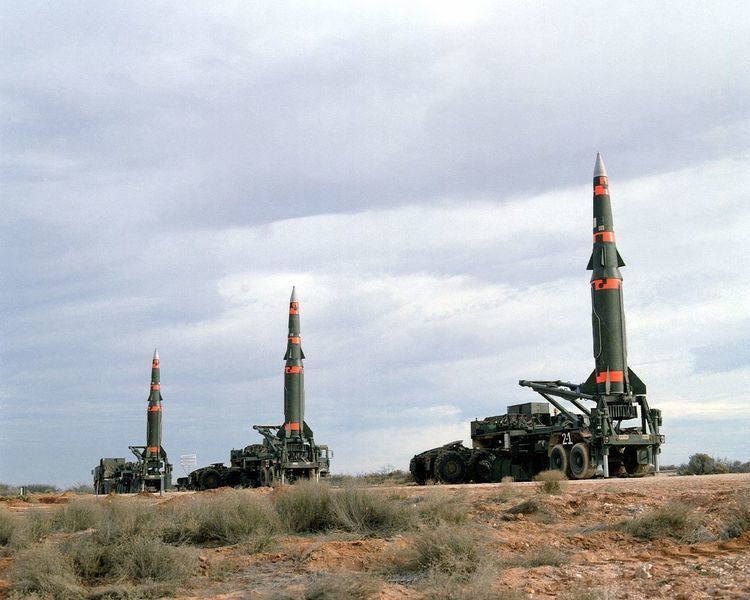 | ||
From 1960 to 1988 there were Pershing missile launches for testing from various sites in the US. The systems included the Pershing 1 Field Artillery Missile System, the Pershing 1a Field Artillery Missile System and the Pershing II Weapon System. Initial launches were from what is now the Eastern Range at Cape Canaveral, Florida using Launch Complex 30A using the dismounted erector launcher. Later launches were from the full transporter erector launcher (TEL). Further launches were conducted at White Sands Missile Range (WSMR) using tactical equipment. The Pershing 1 and 1a had a range of 740 kilometres (460 mi), thus launches were from various subinstallations into WSMR. The two-stage Pershing II had a range of 1,770 kilometres (1,100 mi), thus launches at WSMR used a single-stage missile with two-stage launches at Cape Canaveral Launch Complex 16.
Contents
Purpose
Initial missile launches were for research and development purposes. There were 52 R&D launches in the Pershing 1 development cycle.
In 1965, the Army contracted with the Applied Physics Laboratory (APL) of Johns Hopkins University to develop and implement a test and evaluation program. APL developed the Pershing Operational Test Program (OTP), provided technical support to the Pershing Operational Test Unit (POTU), identified problem areas and improved the performance and survivability of the Pershing systems.
POTU planned, scheduled, and executed the tests, evaluations, and missile firings to support OTP. POTU would select three firing batteries from the 56th Field Artillery Command in West Germany to participate in Follow-on Operational Tests (FOT) using an unannounced field alert status verifications (FASV) at the Quick Reaction Alert (QRA) site. POTU selected missiles, equipment and personnel (colloquially referred to as a tap) for transport to either Cape Canaveral or White Sands Missile Range. After arrival, the missiles and launchers would be equipped with telemetry and the missiles would have range safety equipment installed for in-flight destruction if needed. Shoots were supported by elements of the 3rd Battalion, 9th Field Artillery Regiment from Fort Sill, Oklahoma. The missile crews would perform tactical countdowns and launch the missile. Data collectors from APL observed the crews and equipment. After the shoot, data and evaluations were compiled into reports of the performance estimates of the operational capabilities of the Pershing missile system.
Markings and telemetry
Initial test missiles were painted white with black striping in a roll pattern that aided in tracking and observation of roll. Tactical missiles were painted green. Pershing 1 and 1a missiles tapped for a shoot would have orange stripes added to the rocket motors and the guidance section and had a dummy warhead with black and white roll pattern. Pershing II missiles had orange and yellow stripes added for tracking. The white tip of the Pershing II was not a marking, it was a radome formed of a radar transparent ablative heat shield.
The missiles had dummy warheads that contained telemetry equipment that monitored missile operation and radioed it back to the ground station. The Pershing 1 and Pershing 1a programmer test station and the erector launcher had a recorder installed to monitor all signals; for Pershing II this was installed on the erector launcher.
Postal covers
The post offices at White Sands Missile Range and Cape Canaveral issued event covers for all launches. Most covers were created using a rubber stamp with the image of a generic missile and a stamped date and time. The first eight launches of the Pershing 1a were recognized with a specially printed cover.
Launches
Pershing II
The first Pershing II launches were in 1977 using the original design configuration with the Pershing 1a motors and a new re-entry vehicle. The 1979 decision to increase the Pershing range necessitated the development of new motors.
